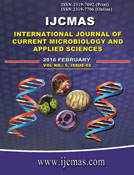


 National Academy of Agricultural Sciences (NAAS)
National Academy of Agricultural Sciences (NAAS)

|
PRINT ISSN : 2319-7692
Online ISSN : 2319-7706 Issues : 12 per year Publisher : Excellent Publishers Email : editorijcmas@gmail.com / submit@ijcmas.com Editor-in-chief: Dr.M.Prakash Index Copernicus ICV 2018: 95.39 NAAS RATING 2020: 5.38 |
Cassava is an important food security crop in the semi-arid areas of Eastern Kenya. Despite its importance during the long periods of drought and famine, no breeding programme has ever been conducted to improve the crop in Eastern Kenya. Therefore, this study was initiated by engaging farmers to identify researchable constraints that limit cassava production in the semi-arid areas. Participatory rural appraisal (PRA) tools, including two focus group discussions and interviews with 72 individual farmers, were conducted in Machakos, Kitui and Makueni counties in the eastern province of Kenya in 2004. Results from interviews revealed that farmers were growing 13 varieties, which were all late maturing (15 to 24 mo). The varieties were usually intercropped with other crops. Many farmers planted cassava after weeding the first planted grain crop, which exposed the crop to early season drought. Gender differences were apparent, as male farmers showed high preferences for varieties that produce long and thick round roots for the markets, while women preferred short and round roots that are easy to handle for domestic use, as well as for the local market. Both focus group and individual farmer interviews identified 11 production constraints that were perceived to be important. Farmers prioritised these constraints to the four most important ones, which in order of importance were drought, lack of suitable planting material, insect pests (green mites and mealy bugs) and disease (cassava mosaic). It was therefore agreed that breeding for early bulking varieties (6 to 10 mo) that escape late season drought was a priority. Breeding should also incorporate resistance to the important disease and pests. In addition, researchers should develop germplasm multiplication and dissemination methods for semi-arid areas.
 |
 |
 |
 |
 |